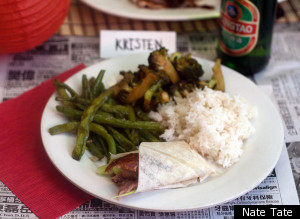
This week's post is written by Mary Kate Tate
Picture 16 people crammed around two card tables in a tiny New York City studio apartment for Thanksgiving dinner. The guests are sitting on a laundry hamper, the edge of my bed, and a few folding chairs, with their chopsticks poised to eat the Peking Duck, dumplings, and stir-fried dishes I had prepared on my two-burner stove and antique oven. While this scene might sound like a disaster, it was actually a raging success and one of the most fun (if non-traditional) Thanksgivings I've ever hosted. Because Chinese food is served family-style, it is perfect for entertaining a lot of people. I love turkey and stuffing as much as the next guy, but if you're looking to try something new this year for your Thanksgiving feast, I recommend cooking Chinese and swapping the turkey for Peking Duck (Beijing Duck).
The Emperor of China's personal chefs created Peking Duck centuries ago in Beijing. Then prepared exclusively for royalty, it is now enjoyed by people all over the world. The traditional way of making Peking Duck uses an elaborate cooking process. A chef first uses a pump to inflate the duck with air so that the skin separates from the meat. Next the duck is glazed with sugar and left to air-dry in a drafty place, which helps the skin roast crispy later. Finally, the duck is slow-roasted for hours over wood coals made from fruit trees until the skin turns a dark orange color. The roasted ducks you see hanging in Chinese restaurant windows have likely been cooked this way.
You wouldn't want to recreate this extravagant cooking method at home, but you can cook a delicious version of Peking Duck nonetheless. The trick is getting the skin crispy while keeping the meat inside moist. This recipe does that and never fails to impress. After cooking, carve the duck tableside into thin pieces and instruct your guests to roll the meat up fajita-style inside thin crepes along with cucumber and scallion slivers and a smear of sauce. Ducks are fattier birds than turkeys so the meat is extremely succulent and moist. Don't forget to ask your guests beforehand to bring along Chinese side dishes like stir-fried snap peas or mapo tofu to add to the feast.
Part of the fun of cooking a big Chinese dinner is setting the table and putting out decorations. I recommend forgoing a tablecloth and instead covering your dining table with pages from a Chinese newspaper (you can pick one up at any Asian grocery store). Besides catching stray food that falls from your guests' chopsticks, the paper looks really cool and the advertisements are fun to look at.

Tips:
-- Cover the dining table with Chinese newspaper
-- Give everyone chopsticks and lessons as required (no cheating with forks!)
-- Use red napkins and fold them like fans
-- Play Chinese music in the background (check out "Chinese flute" music in the iTunes store)
-- Hang red paper lanterns
-- Serve bottles of Chinese Tsingtao beer (a must!)
-- Make place setting cards by painting guests' names on white paper cards with a small paint brush and black to look like Chinese calligraphy
北京烤鸭
Serves 4 to 6

1 (5-pound) duck
3 tablespoons honey
1 tablespoon Shaoxing rice wine or dry sherry
1 tablespoon warm water
8 green onions, white parts only, slivered into 3-inch lengths
1 medium English cucumber, peeled and slivered into 3-inch lengths
20 Mandarin Pancakes (purchased frozen, also called Moo-Shu Shells)
1/2 cup Chinese sweet noodle sauce
NOTE: Contrary to popular thought, the brown sauce served with Peking Duck in China is Chinese sweet noodle sauce, not plum sauce. If you have trouble finding Chinese sweet noodle sauce, go to your local Asian grocery store and show the sales clerk these Chinese characters: 甜面酱 (tián miàn jiàng).
INSTRUCTIONS
Bring a large pot of water to a boil. Use a knife to scrape any rough patches off the duck's skin. Remove the innards if necessary, cut off the wing tips, and remove excess fat around the cavity opening. Rinse the duck and blanch in the boiling water for 4 minutes. Remove and pat dry with paper towels.
Combine the honey, rice wine, and warm water in a small bowl. Liberally brush several coats of the honey mixture all over the duck. Place the duck upright in a refrigerator and let dry for 6 hours, uncovered -- or speed up this step by drying the duck with a hair dryer for 20 minutes. (We developed this shortcut one night when we were running way behind schedule. The results are comparable. However, try to complete this special step before your guests arrive, as you will look silly blow-drying dinner in the kitchen!)
Preheat the oven to 400°F. Place the duck breast-side up on a broiling pan and roast for 1 hour and 20 minutes or until the internal temperature of the duck reaches 165°F on a meat thermometer. Check on the duck while it cooks. The duck skin should turn a deep orange-brown color but if it starts to burn, cover it loosely with foil to stop it from burning.
Place the green onions and cucumber slivers on a serving plate. Warm the individual pancakes in a dry skillet over high heat for a few seconds and place them on a separate serving plate. Carve the duck with a sharp knife into thin strips and arrange the meat on a platter. Now you are ready to make Chinese fajitas: Roll some of the duck meat, green onions, cucumber, and a smear of Chinese sweet noodle sauce up in a Mandarin pancake, eat, and repeat.